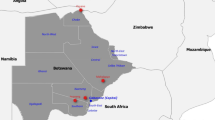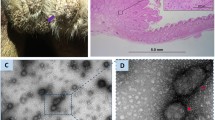Abstract
A total of six cases and 37 suspect cases of skin avipoxvirus infection in great tits (Parus major) have been described in central Europe since 2005. Most of the cases were diagnosed during the winter season, from October to March. Analyses of the 4b core protein gene showed identical or almost identical DNA sequence in six isolates (one from Austria, three from Hungary, and two from Czech Republic). A morphogenesis of the avipoxvirus including a constitution of acidophilic-type inclusions (ATIs) was documented by electron microscopy in cells from lesions on great tits found in Czech Republic. Moreover, the ATI body protein gene was demonstrated using polymerase chain reaction in the isolate that caused ATIs. A number of new cases of poxvirus infection in great tits have emerged in central Europe since 2005, and the reason for this sudden increase remains unknown.



Similar content being viewed by others
References
Adamik P (2008) Great tit. In: Cepak J, Klvana P, Skopek J, Schropfer L, Jelinek M, Horak D, Formanek J, Zarybnicky J (eds) Czech and Slovak bird migration atlas. Aventinum, Prague, pp 473–474 In Czech with a summary in English
Afonso CL, Tulman ER, Lu Z, Zsak L, Kutish GF, Rock DL (2000) The genome of fowlpox virus. J Virol 74:3815–3831
Bejcek V, Stastny K, Hudec K (1995) The atlas of wintering birds in the Czech Republic, 1982–1985 (270pp.). H and H Publishing, Jinocany In Czech with a summary in English
Bolte AL, Meurer J, Kaleta EF (1999) Avian host spectrum of avipoxviruses. Avian Pathol 28:415–432
Boulanger D, Smith T, Skinner MA (2000) Morphogenesis and release of fowlpox virus. J Gen Virol 81:675–687
Buller RM, Arif BM, Black DN, Dumbell KR, Esposito JJ, Lefkowitz EJ, McFadden G, Moss B, Mercer AA, Moyer RW, Skinner MA, Tripathy DN (2005) Family Poxviridae. In: Fauquet CM, Mayo MA, Maniloff J, Desselberger U, Ball LA (eds) Virus taxonomy, classification and nomenclature of viruses, eighth report of the International committee on the taxonomy of viruses. Elsevier Academic Press, San Diego, pp 117–133
Cheville NF (1966) Cytopathologic changes in fowlpox (turkey origin) inclusion body formation. Am J Pathol 49:723–737
Easterbrook KB (1966) Controlled degradation of vaccinia virions in vitro: an electron microscopic study. J Ultrastruct Res 14:484–496
Goodpasture EW, Anderson K (1962) Isolation of wild avian pox virus including both cytoplasmic and nuclear inclusions. Am J Pathol 40:437–453
Gruber A, Grabensteiner E, Kolodziejek J, Nowotny N, Loupal G (2007) Poxvirus infection in a Great tit (Parus major). Avian Dis 51:623–625
Holt G, Krogsrud J (1973) Pox in wild birds. Acta Vet Scand 14:201–203
Illera JC, Emerson BC, Richardson DS (2008) Genetic characterization, distribution and prevalence of avian pox and avian malaria in the Berthelot’s pipit (Anthus berthelotii) in Macaronesia. Parasitol Res 103:1435–1443
Jarmin S, Manvell R, Gough RE, Laidlaw MS, Skinner MA (2006) Avipoxvirus phylogenetics: identification of a PCR length polymorphism that discriminates between the two major clades. J Gen Virol 87:2191–2201
Jarvi SI, Triglia D, Giannoulis A, Farias M, Bianchi K, Atkinson CT (2008) Diversity, origins and virulence of avipoxviruses in Hawaiian forest birds. Conserv Genet 9:339–348
Kulich P, Roubalova E, Dubska L, Sychra O, Smid B, Literak I (2008) Avipoxvirus in blackcaps (Sylvia atricapilla). Avian Pathol 37:101–107
Lee LH, Lee KH (1997) Application of the polymerase chain reaction for the diagnosis of fowlpox virus infection. J Virol Methods 63:113–119
Lierz M, Bergmann V, Czerny CP, Lueschow D, Mwanzia J, Prusas C, Hafez HM (2007) Recurrence of an avipox-infection in a collection of captive stone curlew (Burhinus oedicnemus). J Avian Med Surg 21:50–55
Literak I, Hromadko M, Blazkova P, Holmberg T (2004) Fagelkoppor vid Ansjon och i Narke (Avian pox in Ansjon and Orebro, Sweden, in Swedish with a summary in English). Arsrapport Annsjons fagelstation 2003 (Lake Annsjon Bird Observatory, Sweden, Annual Report 2003). Faglar i Jamtland-Hajedalen 1:4–7
Lueschow D, Hoffmann T, Hafez HM (2004) Differentiation of avian poxvirus strains on the basis of nucleotide sequences of 4b gene fragment. Avian Dis 48:453–462
Meyer H, Ropp SL, Esposito JJ (1997) Gene for A-type inclusion body protein is useful for a polymerase chain reaction assay to differentiate orthopoxviruses. J Virol Methods 64:217–221
Noyes WF (1965) Observations on two pox-tumor viruses. Virol 25:666–669
Palade EA, Biro N, Dobos-Kovacs M, Demeter Z, Mandoki M, Rusvai M (2008) Poxvirus infection in Hungarian Great tits (Parus major): case report. Acta Vet Hung 56:539–546
Polowinkin P (1901) Beitrag zur pathologischen Anatomie der Taubenpocke. Schweiz Arch Tierh.knd 27:86–109
Prose PH, Friedman-Kien AE, Vilcek J (1969) Molluscum contagiosun virus in adult human skin cultures. Am J Pathol 55:349–366
Purcell DA, Clarke JK, McFerran JB, Hughes DA (1972) The morphogenesis of pigeon poxvirus. J Gen Virol 15:79–83
Sadasiv EC (1985) Morphogenesis of canary poxvirus and its entrance into inclusion bodies. Am J Vet Res 46:529–535
Smid B, Valicek L, Mensik J (1973) Replication of swine pox virus in the skin of naturally infected pigs. Electron microscopy study. Zbl Vet Med B 20:603–612
Stastny K, Bejcek V, Hudec K (2006) The atlas of breeding birds in the Czech Republic, 2001–2003 (463 pp.). Aventinum, Prague In Czech with a summary in English
Teppema JS, Boer GF (1975) Ultrastructural aspects of experimental swine pox with special reference to inclusion bodies. Arch Virol 49:151–163
Tulman ER, Afonso CL, Lu Z, Zsak L, Kutish GF, Rock DL (2004) The genome of canary poxvirus. J Virol 78:353–366
Weli SC, Traavik T, Tryland M, Coucheron DH, Nilssen O (2004) Analysis and comparison of the 4b core protein gene of avipoxviruses from wild birds: evidence for interspecies spatial phylogenetic variation. Arch Virol 149:2035–2046
Westwood JCN, Harris WJ, Zwartouw HT, Titmussand DHJ, Appleyard G (1964) Studies on the structure of vaccinia virus. J Gen Microbiol 34:67–78
Williams MG, Almeida JD, Howatson AF (1962) Electron microscopy studies on viral skin lesions. A simple and rapid method of identifying virus particles. Arch Dermatol 86:290–297
Acknowledgments
We would like to thank S. Bosch, J. Cepak, J. Chytil, P. Kafka, V. Kovar, A. Kristin, P. Kverek, L. Novak, K. Novotny, P. Obona, M. Polak, T. Pospisil, J. Stolarczyk, and M. Strnad for information about findings of great tits skin lesion in the wild. This study was funded by grants nos. MSM6215712402 and MZe0002716202 from the Ministry of Education, Youth, and Sports of the Czech Republic and Ministry of Agriculture of the Czech Republic, respectively. The authors declare that the study complies with the current laws of the Czech Republic.
Author information
Authors and Affiliations
Corresponding author
Additional information
Communicated by W. Lutz
Rights and permissions
About this article
Cite this article
Literak, I., Kulich, P., Robesova, B. et al. Avipoxvirus in great tits (Parus major). Eur J Wildl Res 56, 529–534 (2010). https://doi.org/10.1007/s10344-009-0345-5
Received:
Revised:
Accepted:
Published:
Issue Date:
DOI: https://doi.org/10.1007/s10344-009-0345-5




